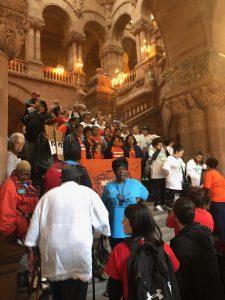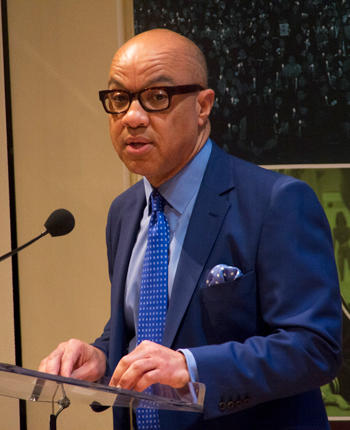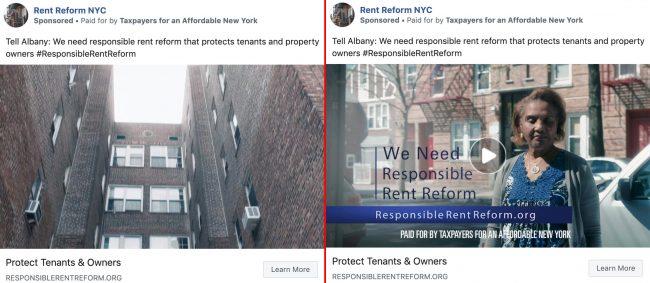From left: New York Communities for Change director Jonathan Westin, Neighborhood First Fund program director Joan Byron, and Ford Foundation president Darren Walker (Credit: NYC Communities, LinkedIn, and Ford Foundation)
With just 11 days left before the rent laws expired, a chain link of tenants formed along the stairs that led to the New York State Assembly chambers, refusing to let anyone — especially real estate lobbyists — in or out.
Their chants filled the hallway outside the chamber doors, where lobbyists and others vied for a chance to influence lawmakers. Clad in red “housing justice for all” t-shirts, the protestors held signs calling on Senate Leader Andrea Stewart-Cousins and Assembly Speaker Carl Heastie to pass nine bills that would radically overhaul New York’s rent stabilization system. Over 60 tenants would be hauled away in handcuffs that day. The acts of civil disobedience dominated the news cycle; the Senate released a statement of support hours later.
Vito López long ago said, ‘I’m going to defeat you every time.’ When you’re the house, everyone expects you to win every time. But you can’t, — Rent Stabilization Association president Joe Strasburg
Across the street at Wellington’s in the ornate Renaissance Albany Hotel, real estate lobbyists gathered around a partially concealed table for a quiet lunch, working as they prefer — behind the scenes.
While industry trade groups spent millions on a traditional ad campaign that highlighted the plight of small landlords and even brought in a powerful union to amplify their message, their opponents pushed a multi-pronged strategy that largely relied on protests and direct contact between tenants and elected officials.
Through over a dozen interviews and an analysis of lobbying disclosures, tax filings and advertising data, The Real Deal assembled the clearest picture yet of how a coalition of 70 different tenant organizations raised half-a-million dollars — still outspent by more than five to one — and set into motion a strategy that helped ultimately turn the tables on the real estate industry, which had held a grip on Albany politicians for a generation.
Bargain hunting
By November, it was clear to the real estate industry that their business interests were under serious threat. A number of far-left-wing candidates, some endorsed by the Democratic Socialists of America, had just picked off reliable incumbents, and they made it clear that rent reform would be a top legislative priority. Though the real estate industry had tangled with activists before and generally came out on top, the political climate felt different this time.
“Vito López long ago said, ‘I’m going to defeat you every time.’ When you’re the house, everyone expects you to win every time. But you can’t,” Rent Stabilization Association president Joe Strasburg said.
Real estate trade organizations such as the Real Estate Board of New York, Community Housing Improvement Program and Rent Stabilization Association quickly began amassing a war chest and outlining a strategy for the upcoming battle. Over the next six months, they would buy media ads and hire well-connected lobbyists to ensure reforms would be incremental, not radical.
Between March and June, the industry’s umbrella lobbying group, dubbed the “Responsible Rent Reform” coalition, spent $2.8 million on print and social media advertising buys, according to lobbying disclosures. They aired television ads from Niagara Falls to Manhattan, and their social media ads reached households as far as Scranton, Pennsylvania, according to advertising data from Facebook. In all, the industry’s campaign spent $73,000 on Twitter and Facebook ads (though none of the ads were targeted, according to Facebook data). Between January and June, at least $750,000 more went to lobbyists hired by LeFrak, Blackstone Group, Cammeby’s International, RSA and REBNY to gin up support from elected officials in the Capitol, according to public lobby disclosures.
Their opponents operated quite differently.
The Upstate/Downstate Alliance, a coalition of more than 70 tenant organizations responsible for the historic legislative defeat of the real estate industry in June, raised a little over $500,000 for their campaign, our analysis shows. That figure is actually smaller than previous legislative campaigns by rent reform groups in Albany, and dramatically smaller than past progressive campaigns like minimum wage.
The $500,000 went toward paying the salary of one full-time coordinator, chartering buses, purchasing vouchers for cafeteria meals for tenants while in Albany, hiring a strategic communications firm, and a handful of targeted Facebook ads (the group spent just $123 on targeted Facebook ads between March and June).
“[Real estate] chose to go on the airwaves while we went to Albany to talk to lawmakers,” said Jonathan Westin, the director of New York Communities for Change, one of the 13 tenant groups that formed the governing body of the coalition. “It was a grassroots coalition, supported by a number of allies on a shoestring budget, that went up against the largest industry in New York that spent millions on commercials, lawsuits and litigations. The Upstate/Downstate campaign was about organizing tenants.”
Coordinated “Tenant Tuesdays” highlighted tenant narratives from around the state. Tenants’ organizing efforts were amplified by volunteers, bolstered by a digital strategy put into action by staff from NYCC. Organizations including the Met Council and the DSA led canvasses and collected data and stories from tenants in key districts. The coalition assembled weekly “digital toolkits” to even the playing field for upstate tenant organizations with fewer staff resources than their downstate coalition partners, while low-cost Facebook ads targeted lawmakers in the final days of the session.

Kawanais Smith
Without a lot of money to spend, the movement relied on tactics largely carried out by volunteers, including direct lobby visits, strategic amplification of tenant stories and dramatic protests.
Rochester tenant leader Kawanais Smith went to Albany 30 times during the legislative session, staying at local apartments in the capital arranged by other tenant organizers. Smith was among the 61 arrested outside the Senate chambers on June 4.
“It’s hard to convince tenants to do anything, but you have to stand up for something,” she said. “I’d have been so quiet before. But I’ve changed, I found my voice, now I speak up for other tenants.”
Where the money came from
Though much of the tenant groups’ strategy relied on sympathetic tenants publicly appealing to lawmakers, the source of the tenant group’s money is not a matter of public record. Because the Internal Revenue Service does not require nonprofit organizations to disclose their revenue sources (except for private foundations and political organizations), it’s impossible to fully determine who funded the tenant movement.
[Real estate] chose to go on the airwaves while we went to Albany to talk to lawmakers, said Jonathan Westin, the director of New York Communities for Change
Here’s what we do know about the movement’s backers:
The Ford Foundation appears to be the biggest funder of progressive housing issues in New York, and the nonprofit has increased its funding levels in the last two years. TRD’s analysis found that the Ford Foundation has granted at least $6.7 million to New York nonprofits for housing-related issues since 2018.
In 2018, it gave $700,000 to a general fund operated by NYCC, following a series of similar grants from 2014 to 2016. The Upstate/Downstate Alliance is mentioned in a $438,000 expense line in 2017, that states the fund “is working with and on behalf of tenants throughout New York.” The description also says the funding will go toward taking action “to win housing justice for all.”
A spokesperson for the Ford Foundation — which has not previously been identified in news reports as a key backer of New York tenant causes — said the grant was not earmarked specifically for rent reform, and NYCC was permitted to spend the money as it saw fit.
The Ford Foundation has also funded several other nonprofits in the tenant coalition, including Make the Road, to which it gave $3 million through a 2017-2018 grant.

Ford Foundation president Darren Walker (Credit: Melissa Bunni Elian via Flickr)
“The funding levels have risen in recent years as we have made multi-year grants to build the organizational capacity of key grantees working in multiple issue areas across the state,” a spokesperson for the Ford Foundation said in a statement to TRD.
Other prominent nonprofit backers include the Oak Foundation, a family foundation based in Geneva, Switzerland, which gave $750,000 to NYCC from 2018 to 2021; and the North Star Fund, which gave $10,000 to Tenants and Neighbors, $5,000 directly to the Upstate/Downstate Alliance and $2,000 to Met Council.
NYC-based Neighborhoods First Fund, which is also funded by the Oak Foundation, the Ford Foundation and Deutsche Bank, gave $150,000 directly to the tenant campaign.
Neighborhood First Fund program director Joan Byron said that the grants her organization made were to support housing nonprofits’ ongoing work, and that philanthropy has been “responding to the [movement’s] agenda, not setting it.”
Though they were outgunned by the real estate industry, several of the 70 nonprofits in the coalition have sizable budgets. In 2017, NYCC reported $2.9 million in revenue and Make the Road reported $22 million in revenue, though they work on far more than just tenant causes.
Union alliances
Many of the tenant groups and their allies also committed to providing employee hours and facilities, like meeting space in New York City and Albany. Ellen Davidson, an attorney from Legal Aid Society, reiterated that support for the campaign wasn’t just from grants— her organization, like others, committed to providing staff hours. And 307 individual donations from donation platform Action Network, while not the lion’s share of the money received, paid for events and direct actions.

Cara Noel
The support of organized labor also played a crucial role in the campaign: while 32BJ backed the industry campaign and sent members to Albany to highlight how the new rent laws would affect construction workers, 1199 SEIU, a union that represents healthcare workers, paid for buses and lunches for tenants and members who went to Albany to testify, according to 1199 SEIU spokesperson Cara Noel. Twelve other unions — including 1199 SEIU, United Auto Workers and Hotel Trades Council — wrote of their support for universal rent control in a May 13 letter, just one month before the new rent law was signed. Still, a campaign with the full backing and financial support of organized labor would have been very different.
“When all of the unions throw their weight behind a campaign there’s a much much bigger budget. More earlier would have been helpful,” a tenant coalition leader said.
Money doesn’t completely account for the tenants’ stunning victory, but it is unlikely they would have succeeded without any. In a series of upcoming profiles, TRD will take readers inside the tenant movement, examining key strategic figures who helped topple the real estate industry, waging a complex state-wide campaign from social media to the state capitol, from Rochester to Ridgewood, eventually wresting control of Albany politicians from the real estate industry.
Additional reporting by Kathryn Brenzel

